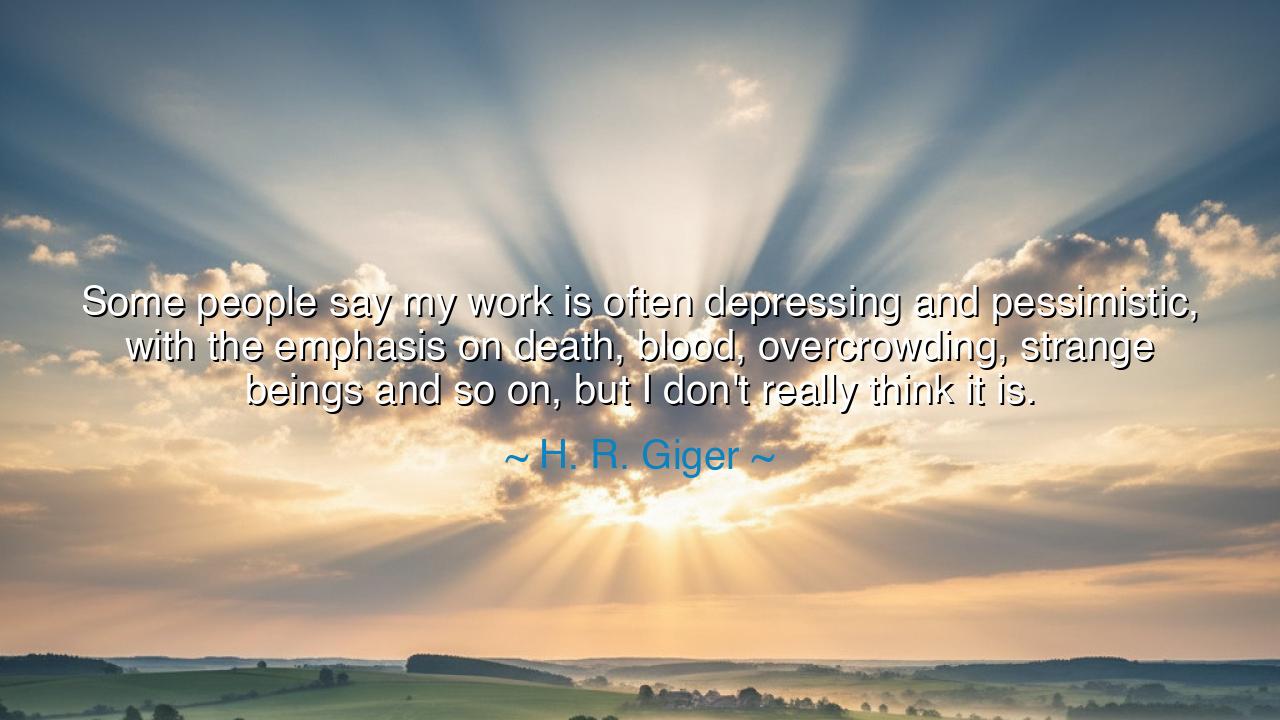
Some people say my work is often depressing and pessimistic, with
Some people say my work is often depressing and pessimistic, with the emphasis on death, blood, overcrowding, strange beings and so on, but I don't really think it is.






The words of H. R. Giger — “Some people say my work is often depressing and pessimistic, with the emphasis on death, blood, overcrowding, strange beings and so on, but I don't really think it is.” — emerge from the shadowed realm of an artist who peered into the abyss and found not despair, but creation. In them, we hear the voice of a man misunderstood by those who mistook his darkness for decay. Giger, the visionary who sculpted nightmares into beauty, speaks here as one who sees beyond the veil — who recognizes that even in death and chaos, there lies a profound order, a divine truth. His art, filled with biomechanical forms, surreal landscapes, and alien creatures, was never meant to celebrate horror, but to reveal the unity between life and death, the flesh and the machine, the human and the infinite.
To understand this quote, one must first understand the mind of Giger and the world he inhabited. He was a son of the twentieth century — an age of machines, wars, and existential dread. From these modern cataclysms, his imagination drew its fuel. Yet while others fled from the grotesque, Giger embraced it, transforming fear into fascination. His paintings and sculptures, populated by strange beings and hybrid forms, confront us with what we repress: our mortality, our technology, our longing for transcendence. When he says he does not find his work depressing, it is because he does not see death as an end or horror as evil — he sees them as reflections of the human condition, beautiful in their truth.
The ancients, too, would have understood this vision. To them, death was not a shadow to flee, but a doorway to wisdom. The Egyptians painted the walls of their tombs with scenes of judgment and rebirth; the Greeks told stories of descent into the underworld, not to glorify despair, but to honor transformation. So it is with Giger. His art is not pessimism; it is myth reborn in the modern age — the mythology of machines and flesh, of creation tangled with decay. Where others saw horror, Giger saw the eternal cycle — destruction giving birth to form, and form dissolving again into the formless. Like the philosophers of old, he reminds us that to look unflinchingly upon death is not to be morbid, but to awaken to the preciousness of life.
There is an ancient truth whispered within his defiance: that beauty is not only found in purity, but also in shadow. Consider the Gothic cathedrals of medieval Europe — towering monuments adorned with gargoyles, angels, and demons entwined. Their architects understood that light alone cannot make holiness; it is the presence of darkness that gives light its power. Giger’s art, too, dwells in that sacred tension. His vision, unsettling though it may be, teaches us that to deny the grotesque is to deny half of reality. The human soul is not made of serenity alone — it is carved from terror and wonder alike.
A living example of this truth can be found in Francisco Goya, the Spanish painter who journeyed from portraits of kings to the haunting depths of The Black Paintings. In those works, filled with madness, war, and despair, Goya revealed the sickness of his age. Yet he, like Giger, was not a pessimist. He was a truth-teller, compelled to expose what others could not bear to see. His art was medicine, bitter but necessary. Likewise, Giger’s work — from the alien birth chambers of Alien to the surreal landscapes of his Necronomicon — is not a hymn to horror, but a mirror held up to the world, reflecting the industrial age’s fear of its own creations.
When Giger says his work is not depressing, he is teaching us a deeper lesson: that meaning is not always found in comfort. The soul must sometimes descend into darkness to understand light. It is in our nightmares that we discover our deepest desires; it is in our fears that we confront what makes us human. Giger’s vision calls us to courage — to look at the monstrous within and recognize it as part of the divine. In this way, his art becomes not an expression of despair, but of acceptance — acceptance of the totality of existence, in all its terrifying and transcendent forms.
The lesson for us is clear: do not flee from what frightens you. Instead, seek to understand it. Look into the shadowed corners of your own life and see what beauty hides there. The world is not divided between good and evil, life and death, beauty and horror — it is a tapestry woven from them all. When we dare to face the dark with open eyes, we find that it, too, contains light.
So let the words of H. R. Giger be your guide: “I don’t really think it is [depressing].” Do not mistake depth for despair, nor shadow for sin. The artist who walks through the valley of death and brings back vision is not a pessimist, but a prophet. To live fully is to embrace all of life — its decay and its creation, its terror and its tenderness — and to see, as Giger saw, that even the darkest dream is still part of the great design.






AAdministratorAdministrator
Welcome, honored guests. Please leave a comment, we will respond soon